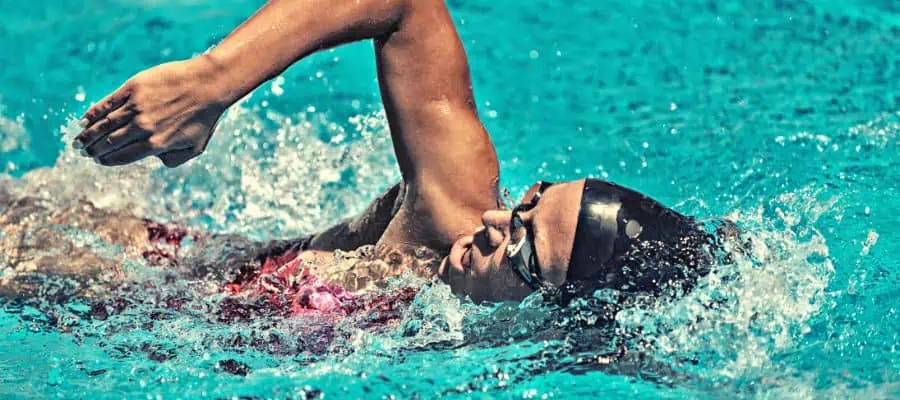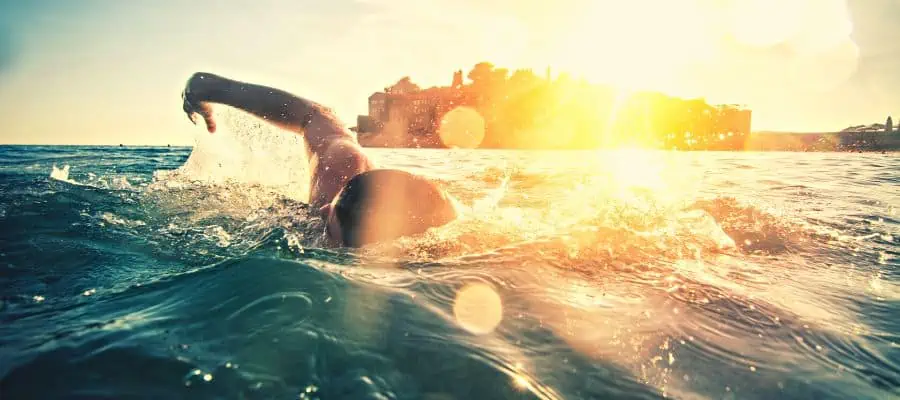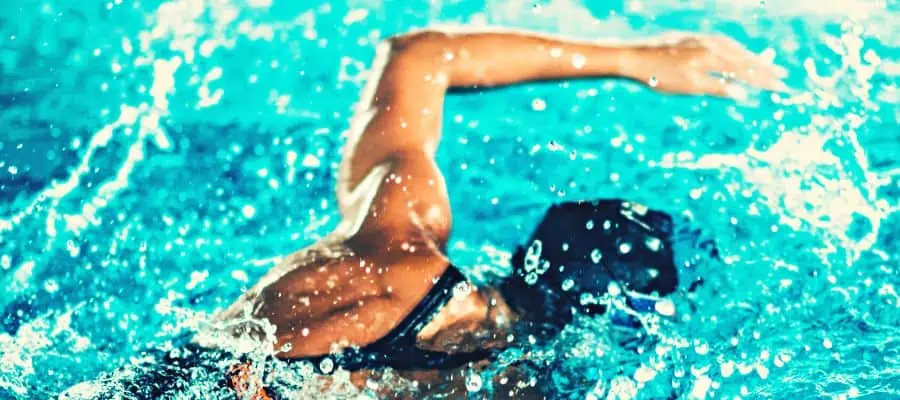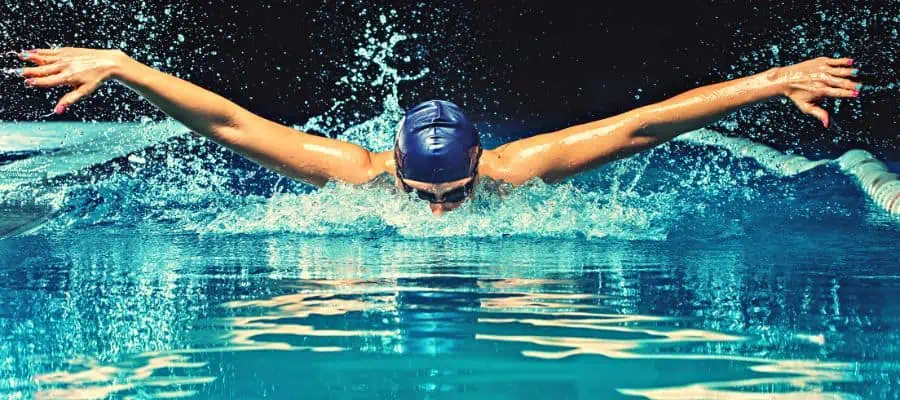Swimming and martial arts may seem unrelated, but they share largely. Many martial artists use swimming to help them get better at their sport.
But does swimming really help in martial arts? In General, swimming provides numerous benefits for martial artists, including improved cardiovascular endurance, increased strength, enhanced flexibility, and better mental focus. By incorporating swimming into their training routine, martial artists can experience significant improvements in their performance while reducing the risk of injuries.
And what is the science behind it, and how can you use it to improve on your martial arts journey? We will have to dive deeper (pun intended) to find answers to these questions.
How Can Swimming Help Martial Arts Athletes?

Swim To Boost Your Heart And Lungs
Swimming is a fantastic way to improve cardiovascular endurance. Regular swimming sessions allow you to experience a full-body workout that requires constant movement and deep breathing. This activity trains your body to use oxygen more efficiently, which is crucial for martial arts performance.
The stronger your heart and lungs are, the better you can perform in your martial arts training. Moreover, swimming increases stamina, enabling you to engage in longer and more intense martial arts sessions without getting tired quickly.
The benefits of improved cardiovascular endurance go beyond the dojo. They contribute to overall health and well-being, making you feel more energized and alert throughout the day.
Build Muscle And Flexibility In The Water
Swimming also contributes to building muscle and enhancing flexibility. The water’s resistance forces your muscles to work harder during each movement, increasing strength. As you consistently swim, you’ll notice improvements in your upper and lower body strength and durability. This is particularly beneficial for martial artists who rely on powerful strikes, holds, and other techniques that require considerable strength and durability.
Additionally, swimming helps you stretch and “lengthen” your muscles, improving your overall flexibility. This increased range of motion can significantly benefit martial artists, allowing for smoother execution of kicks, throws, and other techniques.
Furthermore, improved flexibility can help reduce the risk of injuries during martial arts practice, ensuring a longer and healthier training experience. Incorporating swimming into your training routine can also improve balance and coordination, vital for martial arts performance.
Staying Healthy And Avoiding Injuries
One of the best aspects of swimming is its low-impact nature. Unlike many other forms of exercise, swimming doesn’t put excessive stress on your joints, which means you’re less likely to get hurt. This is particularly beneficial for martial artists, as it allows them to maintain their fitness levels without causing undue wear and tear on their bodies.
Additionally, swimming can be an effective recovery and rehabilitation tool for martial artists recovering from injuries. The buoyancy of the water provides a peaceful environment for healing, helping you get back to your martial arts training faster and healthier.
Swimming can also aid in preventing common injuries in martial arts, such as sprains and strains, by strengthening muscles and connective tissues and promoting better flexibility.
Use Swimming To Drop The Weight

Swimming is an effective calorie-burning exercise, making it useful for athletes looking to manage their weight. The number of calories burned during a swimming session depends on various factors, such as the intensity of the workout, individual body weight, and the swimming stroke used.
On average, a person can burn between 400-700 calories per hour while swimming. Still, this number can be even higher when swimming in colder water.
Cold Water Calorie Burner
Swimming in cold water can significantly increase the number of calories burned during a workout. When submerged in cold water, the body must work harder to maintain its core temperature, increasing calorie expenditure.
This thermogenic effect can help athletes burn more calories during their swimming sessions, making it an efficient way to shed excess body weight. Additionally, cold water swimming has been linked to increased metabolic rate, which can further contribute to weight loss and improved body composition.
Low-Intensity Swimming For Weight Management
Low-intensity swimming can be an ideal solution for martial artists looking to drop weight without putting too much stress on their joints or compromising their martial arts training. Engaging in low-intensity swimming sessions allows athletes to burn calories while minimizing the risk of injury and muscle strain.
This low-impact form of exercise can complement a martial artist’s regular training routine, providing a safe and effective method for weight management and overall fitness improvement. Incorporating swimming, particularly in cold water, into a martial artist’s training regimen can be a valuable strategy for burning calories and managing weight.
By taking advantage of the calorie-burning benefits of swimming and its low-impact nature, martial artists can improve their body composition and enhance their performance in their chosen discipline.
The Mental Aspect Of Swimming

Clear Your Mind In The Pool
Swimming can be a meditative and peaceful activity that enhances focus and concentration. While swimming, you can direct your attention toward your breathing and the sensation of the water around you, which helps you stay calm and clear-headed.
This mental clarity is essential for martial arts. It enables you to perform better during training by staying focused on your techniques and maintaining a calm demeanor during stressful situations. Swimming also teaches you to control your breathing, which can be particularly helpful in martial arts, where efficient breathing is essential for maintaining stamina and staying calm under pressure.
Feel Good And Stay Balanced
Swimming has been shown to reduce stress levels and improve overall mood. The rhythmic nature of swimming and the release of endorphins contribute to a sense of well-being and emotional balance. This mental stability is crucial for martial artists. It can help them stay focused, perform better during training, and remain resilient during challenging moments.
By incorporating swimming into their routine, martial artists can benefit from its mental and emotional advantages. Furthermore, the reduced stress and improved mood resulting from swimming can positively impact other areas of life, such as work, relationships, and personal well-being, leading to a more balanced and satisfying lifestyle.
Build Mental Toughness And Resilience Through Open Water Swimming
Open-water swimming presents unique challenges that can help martial artists develop mental toughness and resilience. Unlike swimming in a pool, open-water swimming involves dealing with unpredictable conditions like currents, waves, and varying water temperatures.
These challenges force you to adapt and stay focused on your goals, despite the obstacles you may face. Regularly facing and overcoming these challenges, martial artists can develop a strong mindset that translates to their martial arts practice.
Two notable figures who have demonstrated the mental toughness and resilience that can be gained through open-water swimming are David Goggins, a former Navy SEAL and ultra-endurance athlete, and Ross Edgley, a British adventurer and athlete. These individuals have pushed the limits of human endurance and mental fortitude in their open-water endeavors.
David Goggins
David Goggins, known for his incredible mental strength and resilience, has completed numerous ultra-marathons and endurance events, often in extreme conditions. Goggins credits his success to his unyielding mindset, which he has cultivated through challenging physical experiences such as open-water swimming.
His example showcases how embracing the discomfort and unpredictability of open-water swimming can help martial artists develop a similar level of mental toughness and resilience.
Ross Edgley
Ross Edgley made history in 2018 by becoming the first person to swim around Great Britain, a feat that took him 157 days to complete. Edgley faced harsh weather conditions, powerful currents, and extreme fatigue throughout his journey.
His ability to stay focused, adapt to the changing environment, and maintain a positive attitude in the face of adversity is a testament to the mental toughness and resilience that can be developed through open-water swimming. Martial artists can learn from Edgley’s experience and use it to inspire their mental and physical growth.
How To Add Swimming To Your Martial Arts Training?

To maximize the benefits of swimming and martial arts, striking the right balance between the two activities is essential. Consider incorporating a few swimming sessions into your martial arts training each week. This will allow you to work on your strength, flexibility, and focus without compromising your martial arts practice.
Experiment with different schedules and routines to discover the optimal balance that works for you. It’s important to remember that everyone’s needs differ, so don’t be afraid to adjust your routine to best suit your personal goals and commitments. Make sure to pay attention to how your body feels and adjust the intensity and frequency of your swimming sessions accordingly.
Are Any Particular Swimming Strokes More Beneficial For Martial Arts Training?

All swimming strokes benefit martial arts training, but some may be more beneficial for specific physical attributes. For example, the butterfly stroke primarily targets the upper body, making it useful for improving upper body strength and power. The breaststroke emphasizes the lower body, which can help develop leg strength and power.
The freestyle stroke is a full-body workout and can improve cardiovascular endurance, flexibility, and overall body strength. Therefore, it may be the most beneficial stroke for overall martial arts training. Ultimately, the most effective stroke for martial arts training may depend on the individual’s specific goals and needs.
Martial artists may want to experiment with different strokes and incorporate them into their swimming routine based on their training objectives. Additionally, including various strokes can provide a more diverse and challenging workout, resulting in better physical conditioning.
How To Use Swimming For Injury Rehabilitation?

Swimming is a low-impact activity that can be an excellent rehabilitation tool for martial artists recovering from injuries. The buoyancy of the water provides a gentle environment for healing, helping you get back to your martial arts training faster and healthier.
Swimming can also aid in preventing common injuries in martial arts, such as sprains and strains, by strengthening muscles and connective tissues and promoting better flexibility.
Let’s say, for example, you have an injured shoulder. Approaching an injured shoulder for rehab through swimming involves taking a gradual and individualized approach. Start with slow and easy movements, focusing on a range of motion and proper form.
Begin with floating and basic kicking drills to avoid placing unnecessary strain on the injured area. Once comfortable with these movements, progress to gentle arm movements and strokes, gradually increasing the intensity and duration of the swim as the injury heals.
Working closely with a qualified healthcare professional or certified trainer is important when incorporating swimming into an injury rehabilitation plan. They can help tailor a specific program to meet your individual needs and goals and ensure that your technique and approach are safe and effective. Additionally, they can monitor your progress and adjust your program as necessary.
What Type Of Swim Training Should You Add To Build Endurance For MMA, etc?

Swimming is an excellent way to improve endurance for martial arts, particularly for disciplines like MMA that require short bursts of intense effort. Interval training is a popular swim training method that alternates between high-intensity efforts and rest periods.
This approach helps build endurance by increasing the body’s ability to recover quickly and repeatedly perform at a high level. For MMA, swimmers can try doing several sets of 30-second maximum effort swims, followed by a 10-second rest period, and repeat this cycle for several sets. This mimics the short-burst rounds in MMA, where fighters exert maximal effort in brief intervals before taking a brief break.
Pyramid sets are another training method that can help improve endurance for martial arts. This method involves gradually increasing the intensity and distance of each swim set and then decreasing them. For example, swimmers can start by swimming two lengths of the pool at 80% effort, followed by one length of the pool at 40% effort.
They can then increase to three lengths of the pool at 80% effort, followed by two lengths at 40% effort, and so on, up to a set with maximum effort. This method helps build endurance by gradually increasing the intensity of the workout and allowing for adequate rest and recovery.
Conclusion
In conclusion, swimming plays a significant role in improving martial arts skills. Its ability to enhance strength, flexibility, and mental focus makes it an invaluable addition to any martial artist’s training regimen.
By finding the right balance between swimming and martial arts practice and creating a swimming plan tailored to your goals, you can harness the full potential of aquatic training and elevate your performance in the martial arts arena. So, dive in and experience the transformative power of swimming for yourself! Embrace the fusion of these two disciplines and become a stronger, more focused, and well-rounded martial artist.
Recent Posts
What is Manachai's Fighting Style? Unveiling Muay Thai Mastery
Manachai, a celebrated figure in the Muay Thai world, has captivated audiences with his exemplary martial prowess. Hailing from the heartlands of Thailand, his name is synonymous with the art of...
What Was Chamuekpet Hapalang's Fighting Style? Unveiling Techniques
Chamuekpet Hapalang was a renowned figure in the world of Muay Thai (record 200-48-2), embodying a fusion of Muay Bouk and Muay Khao styles. Originating from Thailand, the art of Muay Thai is known...
